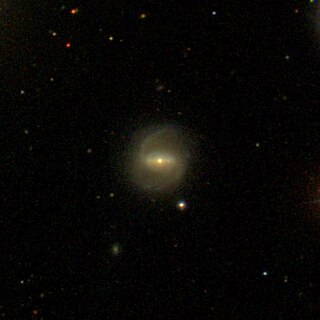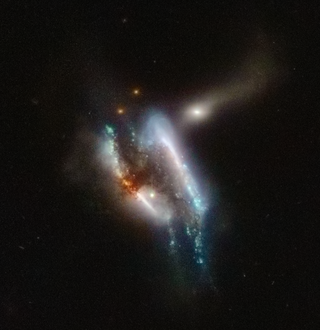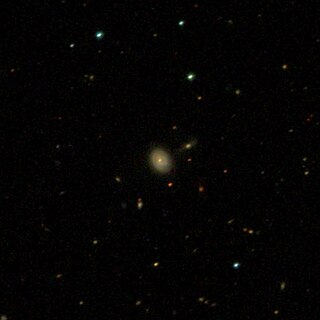
NGC 7012 is a large, bright elliptical galaxy located about 380 million light-years away from Earth in the constellation Microscopium. NGC 7012 was discovered by astronomer John Herschel on July 1, 1834.

NGC 4333 is a barred spiral galaxy with a ring structure located about 330 million light-years away in the constellation Virgo. It was discovered by astronomer William Herschel on April 13, 1784, who described it as "F, pS, R, bM, 2nd of 3". NGC 4333 is also classified as a LINER galaxy. Despite being listed in the Virgo Cluster catalog as VCC 637, it is not a member of the Virgo Cluster but instead a background galaxy.

IC 4271 is a spiral galaxy located some 800 million light-years away in the Canes Venatici constellation. It is 130,000 light-years in diameter. IC 4271 was first located on July 10, 1896, by Stephane Javelle, a French astronomer. It hosts a Seyfert type 2 nucleus, containing an acceleration disc around its supermassive black hole which releases large amounts of radiation, hence its bright appearance. IC 4271 appears to be interacting with its smaller neighboring galaxy, PGC 3096774.

UGC 1840 known as Arp 145, are a pair of interacting galaxies located 250 million light-years away from the Solar System in the Andromeda constellation. Made up of two galaxies, UGC 1840 NED01 and UGC 1840 NED02, the two galaxies had recently collided with each other in which the elliptical galaxy has penetrated through the spiral galaxy's nucleus leaving a hole in its middle, thus forming a ring galaxy. With a diameter of 1.3 arc minutes, close to 100,000 thousand light-years, they are roughly the same size as the Milky Way.

NGC 6331 is a type E elliptical galaxy located in the Ursa Minor constellation. It is located 737 million light-years from the solar system and was discovered by German-British astronomer William Herschel on December 20, 1797, utilizing an 18.7-inch f/13 spectrum telescope but also observed by Guillaume Bigourdan.

IC 2431 are a group of interacting galaxies in the constellation of Cancer. They are located 684 million light-years away from the Solar System and were discovered on February 24, 1896, by Stephane Javelle.

IC 1166 are a pair of galaxies in the Corona Borealis constellation comprising IC 1166 NED01 and IC 1166 NED02. They are located 977 million light-years from the Solar System and were discovered on July 28, 1892, by Stephane Javelle.

IC 1189 is a S0-a lenticular galaxy with a ring structure located in Hercules. It is located 557 million light-years away from the Solar System and has an approximate diameter of 145,000 light-years. IC 1189 was discovered on June 7, 1888, by Lewis Swift. It is a member of the Hercules Cluster.

NGC 3751 is a type E-S0 lenticular galaxy located in the Leo constellation. It is located 450 million light-years away from the Solar System and was discovered by Ralph Copeland on April 5, 1874.

NGC 5098 are a binary pair of distant galaxies located in Canes Venatici constellation. They are made up of one Type E elliptical galaxy, PGC 46529 or NGC 5098 NED01 located east and one Type ES-0 lenticular galaxy, PGC 46515 or NGC 5098 NED02 located west. Both galaxies are located 559 million light-years away from the Solar System and were discovered on April 29, 1827, by John Herschel.

IC 848 is a type Sbc barred spiral galaxy located in Coma Berenices. Its redshift is 0.053077 which corresponds the galaxy to be located 727 million light-years away from Earth. IC 848 has an apparent dimension of 0.80 x 0.6 arcmin, meaning it is about 170,000 light-years across. It was discovered by Stephane Javelle on July 22, 1892, which was described per Dreyer as "extremely faint, very small and difficult".

IC 3078 is a spiral galaxy with a ring structure located in Virgo. Its redshift is 0.066148, meaning IC 3078 is located 905 million light-years from Earth. With an apparent dimension of 0.50 x 0.5 arcmin, IC 3038 is about 133,000 light-years across. It was discovered by Royal Harwood Frost on May 7, 1904 and is listed in the Virgo Cluster catalogue as VCC 174. However, it is not a member of the Virgo Cluster, but instead a background galaxy.

IC 4539 is a type SABb intermediate spiral galaxy located in Corona Borealis. Its redshift is 0.061307, which corresponds IC 4539 to be 845 million light-years from Earth. It has an apparent dimension of 0.40 x 0.4 arcmin, meaning the galaxy is about 95,000 light-years across. IC 4539 was discovered by Stephane Javelle on June 23, 1903, who found it "as faint, small, round with a very brighter middle."

IC 923 is a lenticular galaxy located in Ursa Major. Its redshift is 0.069243 which means the galaxy is 954 million light-years from Earth. IC 923 has apparent dimensions of 0.50 x 0.2 arcmin, meaning it is approximately 139,000 light-years across. IC 923 was discovered in June 1892, by Edward Emerson Barnard and is a member of galaxy group, V1CG 588.

IC 4160, also known as PGC 1677859, is a spiral galaxy located in Coma Berenices. Its redshift is 0.061443, which corresponds IC 4160 to be 846 million light-years from Earth. It has an apparent dimension of 0.40 x 0.2 arcmin, meaning the galaxy is 99,000 light-years across. IC 4160 was discovered by Max Wolf on January 27, 1904.

IC 4163 is a type Sbc peculiar galaxy located in Coma Berenices. Its redshift is 0.064038 which corresponds IC 4163 to be 858 million light-years from Earth. It has an apparent dimension of 0.40' x 0.3' arcmin and was discovered on January 27, 1904, by Max Wolf.

IC 2839, known as PGC 3472295, is a spiral galaxy located in the constellation Leo. Its redshift is 0.065734, which corresponds to the galaxy being located 906 million light-years from Earth. IC 2839 has an apparent dimension of 0.30 x 0.1 arcmin, meaning it spans 79,000 light-years across. The galaxy was discovered on March 27, 1906, by Max Wolf.

IC 4481 is a type SBbc barred spiral galaxy located in Boötes. Its redshift is 0.110727, meaning IC 4481 is located 1.49 billion light-years away from Earth. It is one of the furthest objects in the Index Catalogue and has an apparent dimension of 0.30 x 0.2 [[Minute and second of arc|arcmin]. IC 4481 was discovered on May 10, 1904, by Royal Harwood Frost, who found it "faint, very small, round and diffuse".
IC 2657 is a type E elliptical galaxy located in the constellation Leo. Its redshift is 0.167816, which means IC 2657 is 2.22 billion light-years away. IC 2657 is the second most distant Index Catalogue object after IC 4017 and the brightest cluster galaxy inside a small galaxy group called WHL J111508.7+134141. A large galaxy, measuring approximately 0.30 x 0.3 arcmin, it spans about 202,000 light-years across and was discovered by Max Wolf on March 27, 1906.

IC 3447 is a type Sc barred spiral galaxy located in the constellation Virgo. It has a redshift of 0.092479, which means IC 3447 is 1.27 billion light-years from Earth, making it one of the furthest objects in the Index Catalogue. The galaxy has apparent dimensions of 0.30 x 0.3 arcmin, which means IC 3447 is 111,000 light-years across. It was discovered by Royal Harwood Frost on May 10, 1904.



















